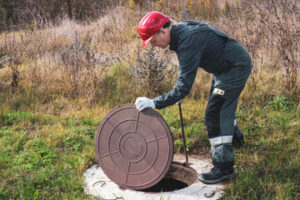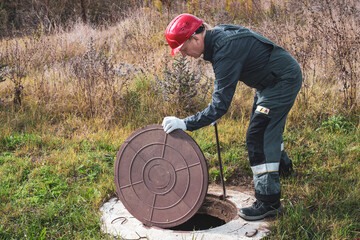A septic tank holds all the wastewater from your toilets, sinks and showers. Solid waste sinks to the bottom of the septic tank and cleaner water rises to the top.
Avoid pouring coffee grounds, bones, cigarette butts, facial tissues, paper towels, chemicals (like drain openers) and sanitary products into your septic system. These items can disrupt the bacterial action in the tank and pollute groundwater. Visit Our Website Here for more information.
A septic tank is an underground container that receives wastewater from toilets, showers, washing machines and sinks. The waste is separated from the water by bacteria that digests the solids. The liquid waste rises to the top of the tank and is called effluent. The sludge that is not digested forms a layer of scum at the surface or settles to the bottom of the tank as a sludge. The septic tank must be large enough to allow solids to decompose for at least 48 hours. Ideally, the tank should be designed to hold up to three years of sludge accumulation.
A tank may be made of concrete, fiberglass, high-density plastic or concrete block and should have a cover that is easy to open and close and that is securely attached. The tank should also have inspection pipes with a cover and a manhole for pumping access. It is a good idea to have a manhole riser that extends to the soil surface or within six inches of the ground surface for ease of maintenance and cleaning.
Ideally, the inlet and outlet tees should be above the level of the scum layer. This will ensure that any solids are retained in the septic tank and do not make their way to your absorption field where they can clog your drains and contaminate soil and water. The septic tank should be located at least 10 feet from the home to reduce the chance of children or unauthorized people getting into it.
The septic tank should be connected to the plumbing drains with watertight 4-inch diameter schedule 40 pipe. The pipe should slope a minimum of 1/4 inch per foot toward the absorption field to prevent clogging. It is recommended to install cleanouts at the septic tank, distribution box and each drain field. A map showing the location of these items and the absorption field should be kept at the house for reference.
A septic system is not the place to dispose of grease, oil, chemical drain openers, paint, varnishes, solvents, fuels, waste oils, photographic solutions or organic chemicals. These can cause a disruption in the bacterial action of the septic tank or pollute the surrounding groundwater.
Septic Tank Pumping
Septic tank pumping is a crucial part of your on-site wastewater system. It’s a process of emptying out all of the accumulated solid waste that settles at the bottom of your septic tank and in other on-site septic tank components like distribution boxes, sludge traps, and drain field lines. This prevents a build-up of these materials from contaminating groundwater and other nearby water sources.
Your septic tank needs to be pumped at regular intervals to ensure that all solid waste has been dissolved and is not being re-deposited into your on-site wastewater system. A licensed septic tank service company can schedule routine septic tank cleaning and inspection services for your property as part of a comprehensive septic system maintenance plan that helps you to avoid costly repairs and replacements in the future.
When it comes to septic tank pumping, the process is much more involved than simply cleaning out your tank’s interior. Septic system professionals will hook up a large vacuum truck to the septic tank and then use high-powered hoses to evacuate all of the liquid effluent and solid sludge from your septic system. This includes septic tank, sludge traps, and other on-site septic system components like distribution boxes and septic dosing chambers.
This process also removes all of the organic sludge that accumulates over time and can clog your septic tank and other on-site septic system parts. The resulting septic waste is removed from your property and transported to a local septic waste dump where it’s disposed of in accordance with strict environmental regulations.
Attempting to perform septic tank pumping or cleaning on your own without a license and specialized equipment can be very dangerous. Not only can it damage your septic system, but it can also lead to hazardous bacteria and pathogens seeping into the surrounding environment, posing health risks to you, your family, and your neighbors.
When a professional septic tank service provider visits your property to perform septic tank pumping, they’ll first locate and establish access to the tank through its large, central access port. It’s important that they don’t clean out your tank through one of its smaller inlet or outlet ports, as doing so can cause damage to the baffles inside of the septic tank.
Septic Tank Repair
Septic systems are self-contained wastewater treatment setups designed for homes that are not connected to municipal sewer lines. They consist of two main parts: a septic tank and a drain field (also called a leach field). The septic tank separates and begins treating solid waste, while the drain field further treats wastewater by dispersing it into the soil. If any part of the septic system malfunctions, it can lead to serious problems that expose your home and family to health risks.
How much it costs to repair your septic system depends on several factors, including the type and extent of damage, as well as where you live. For example, labor costs will vary based on your geographic location and the local contractor’s rates. Repairs that require excavation may also incur higher labor costs. The age of your septic tank also plays a role in cost, as tanks near the end of their expected lifespans tend to be more expensive to repair than newer models.
The most common septic system repairs involve the inlet and outlet pipes, baffles, pumps, and distribution boxes. These components are essential in ensuring that wastewater is adequately treated before it is released into the environment. However, they are prone to wear and tear over time due to their heavy use. They can also break down or become clogged by improper or excessive usage.
Aside from regular septic tank pumping, the best way to prevent costly repairs is to ensure that you only flush human waste and toilet paper into your septic system. Anything else, including cleaning products, grease, oils, and fats, can clog drains and pipes going out of the septic system. Moreover, it is important to avoid putting garbage disposals into your septic system, as they can overwork the septic tank and cause the buildup of sludge.
If you do not get your septic tank pumped on a regular basis, the sludge and scum layers can build up to the point where the liquid layer between them disappears. This will allow septic solids to flow out into the drainfield, where they can clog and infiltrate the soil and groundwater. To keep the septic tank working properly, you should have it pumped twice or three times per year.
Septic Tank Maintenance
If you have a septic system, you’ll need to schedule regular maintenance services for your tank and drain field. These services can help keep your septic system in good working condition, which in turn helps reduce the chances of expensive repairs.
The first step in septic tank maintenance is getting your system pumped out regularly. A septic tank professional will locate and uncover the tank, then use a specialized vacuum to remove all liquid and sludge from the tank. They’ll also clean the septic tank filter to ensure proper flow through the system. Then, the technician will inspect the septic tank itself for cracks or leaks and make sure baffles are intact.
Keeping track of your septic tank’s sludge and scum levels is another important part of septic tank maintenance. If you let solids build up too much, they may enter the drain field and clog it, which can cost you thousands of dollars in repairs and cleanup costs.
A septic tank should be inspected once per year, or more often if you have a lot of people living in your home. During an inspection, a professional will check the sludge and scum levels to ensure that they’re below the early warning levels. They’ll also check the septic tank’s lid and examine the baffles, tees, and floaters. The technician will also look for any wet spots or sewage odors in your yard that could indicate an issue with your septic tank or drain field.
Finally, a septic tank professional will inspect the drain field to see if there are any leaking cracks or damage to the leach field and septic lines. They’ll also look for any wet areas in the soil, which can indicate that water is escaping from the drain field and into the surrounding environment.
You can also keep your septic tank maintenance costs down by being mindful of how you use water in your home. Consider installing water-saving toilets and shower heads, and limit your laundry and dishwasher usage. Don’t flush anything other than human waste and white toilet paper, and avoid putting garbage, coffee grounds, grease, or other materials into your drains.
